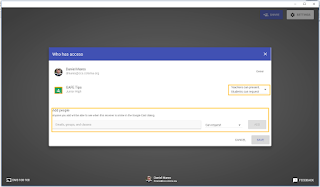First and foremost, the headline is slightly misleading as you will actually display your Chromebook to your desktop which will be connected with wires. While you will need your Windows PC to connect to the projector, it does not change the fact that you can wirelessly display your Chromebook to students. In my experiments with this both at home and on the school network, I have yet to get the sound to work. (If you would like to connect with the HDMI cable that supports both audio and video, please let me know and I will be sure to get you a cable).
To start this process, in your Chrome browser you will need to visit the Chrome Web Store and install the Google Cast for Education app. You will also need to install the Google Cast extension.
Next, on your windows desktop open your Google Cast for Education app. You can find it near the top of your browser window.
Once you open the app, you should be see a gray screen that names the computer and gives you the time. On that screen, select the "Share" button to see who has access to display on your screen with permission and without permission (default is teachers in your Google Classroom have permission, students must ask permission).
After opening the app, head over to your Chromebook and hit “Google Cast” extension which you can find in the upper right-hand corner of your computer.
Once you have opened the Cast extension, simply select your device from the list and you will have your Chromebook screen wirelessly in your classroom.
Next, you will be prompted to select what you wish to share. Do you wish to share just the tab that you are working in or the whole screen (what you see is what is displayed). After, you will then be asked to grant final permissions to display your screen on the desktop.
If you are casting and wish to stop, simply click the cast extension in the browser that is being cast from, and select the stop option. (You can also close out the window of the cast to abruptly stop it).
If you have questions or need help figuring this out, please let me know and I will come help you get set up.
The educational application of this is two fold. First, it gets you out of the front of the classroom to work on something or display something to the class. This allows you proximity to assure that all students are understanding and lets you check for understanding with more students on a more individual setting. Second, you can display student work by having them cast to the screen. If you student is doing great work, you can easily share that work with the class. If a student found an excellent resource, share it with the class and use it to identify the strengths and weaknesses of the source. Either way, there are ways for education to improve with these shared screens.











Comments
Post a Comment